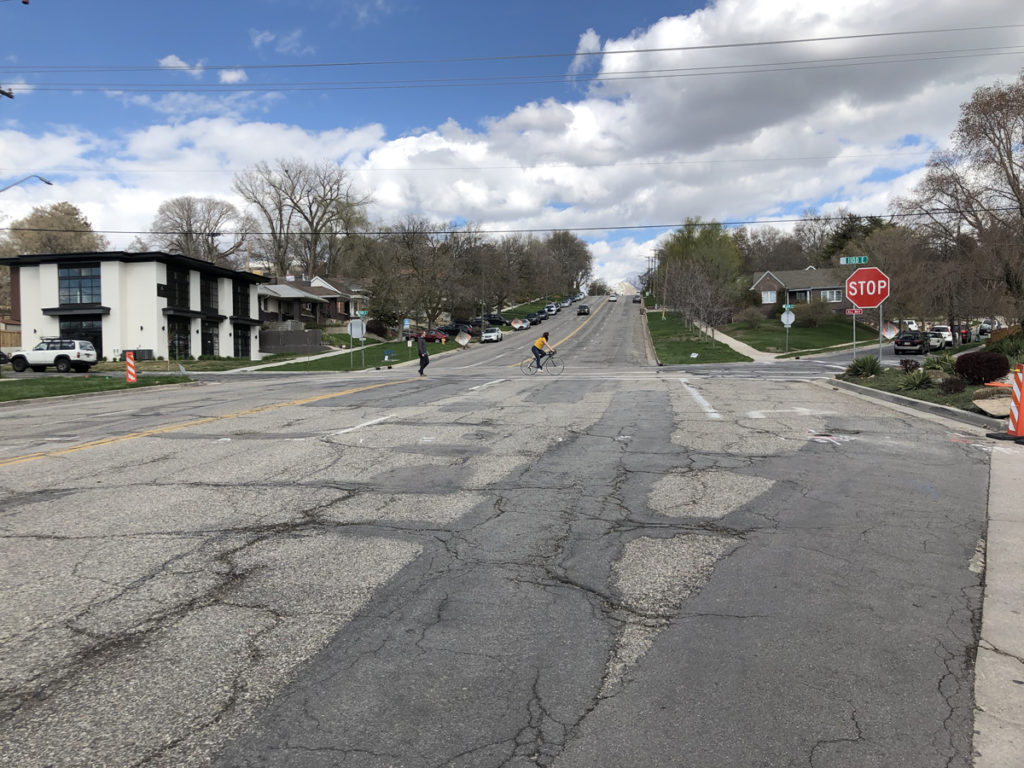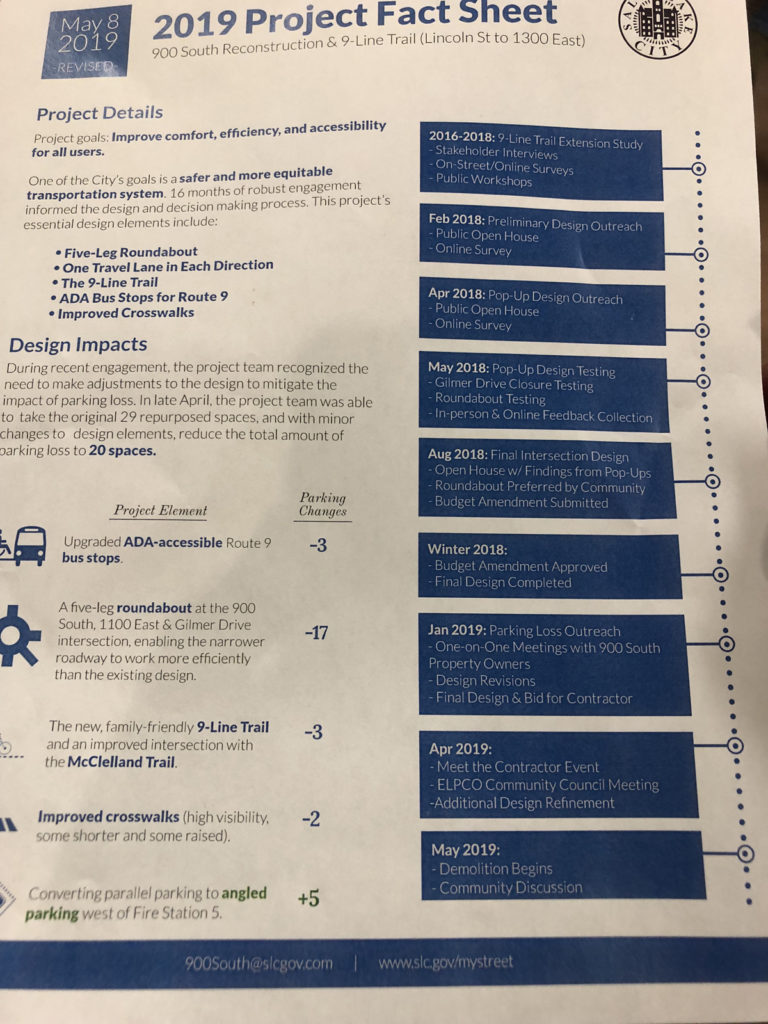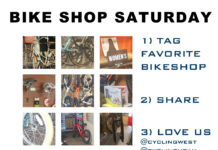May 20, 2019 – Salt Lake City is starting reconstruction of 900 South between Lincoln Street (about 950 E) and 1300 E. The redesign will include a new portion of the 9-Line Shared Use Path, a roundabout at the 5-way intersection at 900 S and 1100 E, better crosswalks, better and ADA compliant bus stops, and a loss of 20 parking spaces. We are in full support of this project but with some additions. It will create better biking conditions and infrastructure in the area.
 The intersection of 900 South and 1100 East will get a 5 legged roundabout with the reconstruction of 900 S. Additionally, a bike path on the southside of the street will be added, along with uphill bike lanes to the east of 1100 East. Photo by Dave Iltis
The intersection of 900 South and 1100 East will get a 5 legged roundabout with the reconstruction of 900 S. Additionally, a bike path on the southside of the street will be added, along with uphill bike lanes to the east of 1100 East. Photo by Dave IltisThe 900 South project webpage and fact sheet states that the following improvements will occur:
The project will include the following features:
- New concrete pavement
- Upgrades to the storm drain system
- Upgrades to signs, crosswalks, and sidewalks as needed
- Reconstruction or repair of driveway approaches as needed
- A new bike path along the south side of the street between Lincoln Street and 1100 East [Section of the 9-Line Trail]
- Uphill bike lanes from 1100 East to 1300 East
- Improved and accessible bus stops
- Additional landscaping between Lincoln Street and 1100 East
From the fact sheet:
One of the City’s goals is a safer and more equitable transportation system. 16 months of robust engagement informed the design and decision making process. This project’s essential design elements include:Five-Leg Roundabout [at 1100 East and 900 S]
One Travel Lane in Each Direction [down from two]
The 9-Line Trail
ADA Bus Stops for Route 9
Improved Crosswalks
Additionally, improved bus service is coming to 900 South in August. And, a low stress bike route is planned for Gilmer Street from 1100 E to 1300 E.
This map shows the details of the redesign of 900 South.
At a recent packed East Liberty Park Community Council forum, held on May 8, 2019, many residents spoke out in favor of the redesign. A disabled woman spoke in regards to the need for increased accessbility. Others spoke in favor of the improvements being good for air quality, the new bike path, and the roundabout. A woman noted that she watch a car go through the intersection of 1100 E and 900 S. at 40 mph, and that she wants her child to be safe. Most people were happy with Salt Lake City’s extensive engagement process, while a few thought that the city did not do much. Note that they have had numerous meetings, pop-up traffic solutions, and public engagement since 2016 as the project fact sheet shows below.
 The project fact sheet for 900 S in Salt Lake City from May 8, 2019.
The project fact sheet for 900 S in Salt Lake City from May 8, 2019.Another person from the neighborhood commented, “Do we want more cars or a clean city?”
We support the project completely, and are glad to see Salt Lake City moving forward with improvements to the street. No one disagrees that the street itself needs rebuilding, as it is currently a pothole filled mess. The section of the 9-Line trail that will be built here on the south side of the roadway will lead to more ways to travel to and through the neighborhood safely, and without using a car. Eventually, the 9-Line trail will connect the Bonneville Shoreline Trail with the Jordan River Parkway Trail. The new section of trail will connect to the McClelland Trail, an intra city urban trail that connects from 800 South to Fairmont Park in Sugarhouse.
But what about the loss of parking? Salt Lake City’s current plans show a loss of 20 parking spots, down from 29 as Salt Lake City planners were able to maintain or add spots to keep nine more places. Isn’t that a good thing? (More on the parking issue).
9th and 9th appears to have plenty of car parking currently. In our experience, we have not had much issue with finding a spot to park when we choose to drive to the neighborhood (yes, we do drive sometimes, but are always working to drive less). We have however had a tough time finding a spot to park a bike on a few occasions.
More parking in 9th and 9th means more cars, and less room for people on foot, bicycles, scooters, skateboards, wheelchairs or other personal mobility devices. The character of 9th and 9th is so inviting because it is relatively easy to walk about, and with lower traffic speeds encouraged by the landscaped medians from 800 East to Lincoln, it’s generally ok for riding a bike (but not great). More parking also results in more driving, and less reason for people to get out of their cars and take transit, bike, or foot.
And, more cars in 9th and 9th means more air pollution, increased carbon emissions, denser traffic, greater traffic crashes, and ultimately a less inviting neighborhood that hurts those businesses that are successful because of the low car, low key character of 9th and 9th.
How do we get to a better 9th and 9th?
How do we get to a lower traffic, calmer, more inviting 9th and 9th? By encouraging non-auto based transportation. This doesn’t mean eliminating cars from the area, but it does mean creating better conditions for other forms of transportation to get to and move about 9th and 9th. Currently, there are some low key routes to 9th and 9th. 800 East is a low stress street (that should become a bicycle boulevard – neighborhood byway (Salt Lake City’s too subtle approach and name for quiet streets). 1100 East is a good route to get to 9th and 9th, but has some stressful barriers like 800 South along the way. McCllelland is a great option from the south. 900 East, however is not so great and needs more traffic calming. It would be make the area more friendly if 900 E were restriped between 800 S and 900 S to include bike lanes.
A calmer 9th and 9th needs lower speed limits. 900 South with the existing and new street design could be lowered to 20 mph similar to 300 South in downtown Salt Lake City. 900 East, while a busy street, is narrower, and needs to be lowered to 25 mph. 800 South’s high speed limits, like many others in Salt Lake City, are nonsensical, varying randomly between 30 mph and 35 mph. All of this leads to a more stressful neighborhood.
A calmer 9th and 9th will likely include a Greenbike bike share station soon. With this likely on the way, better biking and walking infrastructure and fewer cars is necessary.
A calmer 9th and 9th needs more bike parking. If 900 South is to lose 20 parking spots, then Salt Lake City should invest in and immediately add 40-100 new spots to park a bike in the 9th and 9th area. They did not have any foresight on this and did not include this in the project. If car parking is removed, it needs to be replaced immediately with the same or more bike parking.
A calmer, more inviting 9th and 9th means following Salt Lake City’s plan to reconfigure the street, make it more inviting through facilities for people on foot, bicycles, scooters, skateboards, wheelchairs, or other personal mobility devices, and buses. Losing a small amount of parking is not going to hurt the character of the neighborhood, and the additional infrastructure for everyone else is going to be great.
What you can do:
Write a letter of support to Salt Lake City asking them to fully implement the 900 S reconstruction project without any further changes. Ask them to immediately install at least 20 new bike parking spaces. Ask them to reduce the speed limits on 900 South to 20 mph and on 900 East to 25 mph.
Comments can be sent to the following people in Salt Lake City government:
900 South project team: [email protected]
Mayor Jackie Biskupski: [email protected]
Salt Lake City Transportation Director Jon Larsen: [email protected]
Ride your bike
Stop in to the businesses at 9th and 9th on your bike. Let them know that good biking, walking, and transit are important to you and that accessibility for all is needed in the neighborhood.











